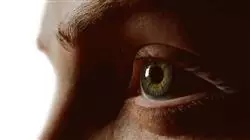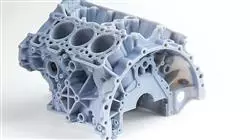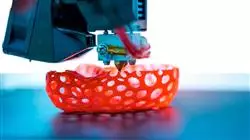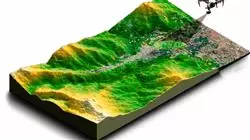University certificate
The world's largest faculty of video games”
Introduction to the Program
Understand the importance of using lighting to create volumes and photogrammetry to achieve perspectives in your projects"

The concept of digital sculpting has changed radically in recent years due to the requirements of the industry. So, at the moment it is complex to separate the texturing, modeling or lighting engines, being an essential requirement to work with low poly system with high poly details and make the models functional for the video game industry and 3D printing.
By no means, we can ignore within the techniques of digital sculpture the newest systems such as VR sculpting, model generation through photographs or modeling within Unreal and Unity. For this reason, this training program includes the most updated concepts and practices on the subject.
As well as all the knowledge required to master a powerful 3D development software such as Blender. A program that has revolutionized the CGI paradigm in recent years and although large companies did not trust it at first, since the release of the LTS versions, it has strengthened its position becoming a market benchmark.
In the same way, an innovative tool of the same software used by large animation studios for the last few years will be implemented: Grease Pencil, its strong point, has rethought concepts of 2D animation, storyboarding, animations and hand painter character creation.
Thanks to TECH's innovative 100% online teaching methodology, students understand the adaptability of their reality and current needs to the learning process, managing the ideal time and place for their studies. A trained teaching team will use numerous multimedia resources to facilitate the process.
Excel in the application of advanced global illumination techniques, augmented reality, VR and 3D printing prototyping in your new projects"
The Model Illumination and 3D Printing, VR, AR and Photogrammetry in Model Illumination and 3D Printing, VR, AR and Photogrammetry contains the scientific most complete and up-to-date educational program on the market The most important features include:
- The development of case studies presented by experts in 3D Modeling and Digital Sculpture
- The graphic, schematic, and eminently practical contents with which they are created, provide scientific and practical information on the disciplines that are essential for professional practice
- Practical exercises where self-assessment can be used to improve learning
- Its special emphasis on innovative methodologies
- Theoretical lessons, questions to the expert, debate forums on controversial topics, and individual reflection assignments
- Content that is accessible from any fixed or portable device with an Internet connection
Enjoy 6 months of learning from experts, who will show you the most up-to-date concepts and case studies on model lighting and 3D printing techniques"
The programs teaching staff includes professionals from the sector who contribute their work experience to this training program, as well as renowned specialists from leading societies and prestigious universities.
The multimedia content, developed with the latest educational technology, will provide the professional with situated and contextual learning, i.e., a simulated environment that will provide immersive training programmed to train in real situations.
This program is designed around Problem Based Learning, whereby the professional must try to solve the different professional practice situations that arise during the academic year. For this purpose, the student will be assisted by an innovative interactive video system created by renowned and experienced experts.
Learn how to use lighting in your creative processes, to expand into the wide possibilities offered by 3D modeling"

TECH offers an exclusive 100% online training, for those who wish to enhance their skills and make their way in a competitive working world"
Syllabus
The structure and distribution of the content of thisPostgraduate diploma in Model Illumination and 3D Printing, VR, AR and Photogrammetry consists of 3 specialized modules, through which the professional will acquire the tools and knowledge of Blender, as a powerful 2D/3D development software. As well as the implementation of lighting to get the most out of three-dimensional creations and finally the creation of organic terrains and environments addressing nature in all its forms. This and more in a secure and dynamic 100% online environment.

A program dedicated to teaching the various techniques of lighting and printing 3D models to achieve outstanding projects in the field of virtual reality and artificial intelligence"
Module 1. Blender
1.1. Free Software
1.1.1. LTS Version and Community
1.1.2. Pros and Differences
1.1.3. Interface and Philosophy
1.2. 2D Integration
1.2.1. Program Adaptation
1.2.2. Crease Pencil
1.2.3. Combination 2D in 3D
1.3. Modeling Techniques
1.3.1. Program Adaptation
1.3.2. Modeling Methodologies
1.3.3. Geometry Nodes
1.4. Texturing Techniques
1.4.1. Nodes Shading
1.4.2. Textures and Materials
1.4.3. Usage Tips
1.5. Lighting
1.5.1. Tips for Light Spaces
1.5.2. Cycles
1.5.3. Eevee
1.6. Workflow in CGI
1.6.1. Necessary Uses
1.6.2. Exports and Imports
1.6.3. Final Art
1.7. Sds Max Adaptations to Blender
1.7.1. Modeling
1.7.2. Texturing and Shading
1.7.3. Lighting
1.8. Knowledge of ZBrush to Blender
1.8.1. 3D Sculpting
1.8.2. Brushes and Advanced Techniques
1.8.3. Organic Work
1.9. From Blender to Maya
1.9.1. Important Stages
1.9.2. Adjustments and Integrations
1.9.3. Exploitation of Functionalities
1.10. From Blender to Cinema 4D
1.10.1. Tips for 3D Design
1.10.2. Use of Modeling Towards Video Mapping
1.10.3. Modeling with Particles and Effects
Module 2. Light Modeling
2.1. Offline Arnold Motors
2.1.1. Interior and Exterior Lighting
2.1.2. Application of Displacement and Normal Maps
2.1.3. Render Modifiers
2.2. Vray
2.2.1. Lighting Bases
2.2.2. Shading
2.2.3. Maps
2.3. Advanced Global Illumination Techniques
2.3.1. ActiveShade GPU Management
2.3.2. Optimization of Photorealistic Rendering Denoiser
2.3.3. Non-photorealistic Rendering (Cartoon and Hand Painted)
2.4. Quick Display of Models
2.4.1. ZBrush
2.4.2. Keyshot
2.4.3. Marmoset
2.5. Rendering Postproduction
2.5.1. Multipass
2.5.2. 3D Illustration in ZBrush
2.5.3. Multipass in Zbrush
2.6. Integration in Real Spaces
2.6.1. Shadow Materials
2.6.2. HDRI and Global Illumination
2.6.3. Image Tracing
2.7. Unity
2.7.1. Interface and Organization
2.7.2. Import to Game Engines
2.7.3. Materials
2.8. Unreal
2.8.1. Interface and Organization
2.8.2. Sculpture in Unreal
2.8.3. Shaders
2.9. Modeling in Video Game Engines
2.9.1. Probuilder
2.9.2. Modeling Tools
2.9.3. Prefabs and Memory Storages
2.10. Advanced Lighting Techniques in Videogames
2.10.1. Realtime, Pre-calculation of Lights and HDRP
2.10.2. Raytracing
2.10.3. Postprocessing
Module 3. Creation of Organic Soils and Environments
3.1. Organic Modeling in Nature
3.1.1. Brush Adaptation
3.1.2. Creation of Rocks and Cliffs
3.1.3. Integration with Substance Painter 3D
3.2. Terrain
3.2.1. Terrain Displacement Maps
3.2.2. Creation of Rocks and Cliffs
3.2.3. Scanning Libraries
3.3. Vegetation
3.3.1. SpeedTree
3.3.2. Low Poly Vegetation
3.3.3. Fractals
3.4. Unity Terrain
3.4.1. Organic Terrain Modeling
3.4.2. Ground Painting
3.4.3. Creation of Vegetation
3.5. Unreal Terrain
3.5.1. Hightmap
3.5.2. Texturing
3.5.3. Unreal’s Foliage System
3.6. Physics and Realism
3.6.1. Physical
3.6.2. Wind
3.6.3. Fluids
3.7. Virtual Walks
3.7.1. Virtual Cameras
3.7.2. Third Person
3.7.3. First Person FPS
3.8. Cinematography
3.8.1. Cinemachine
3.8.2. Sequencer
3.8.3. Recording and Executables
3.9. Visualization of Modeling in Virtual Reality
3.9.1. Modeling and Texturing Tips
3.9.2. Exploitation of Interaxial Space
3.9.3. Project Preparation
3.10. VR Scene Creation
3.10.1. Location of Cameras
3.10.2. Land and Infoarchitecture
3.10.3. Platforms of Use

Excellence makes the difference. Get your degree with this Postgraduate diploma inModel Illumination and 3D Printing, VR, AR and Photogrammetry , VR, AR and Photogrammetry in 6 months and 100% online"
Postgraduate Diploma in Model Illumination and 3D Printing, VR, AR and Photogrammetry
.
Gain specialised skills in model lighting and 3D printing, virtual reality (VR), augmented reality (AR) and photogrammetry with the Postgraduate Diploma programme at TECH Global University. At TECH Global University, we understand the importance of flexibility in your learning. That's why our programme is taught in the form of online classes, giving you the convenience of studying from anywhere and at the time that best suits your needs. Online classes allow you to access the course content and participate in the sessions from the comfort of your home, office or any other place with an internet connection. You can learn at your own pace, review the lessons as often as you wish and enjoy interacting with professionals and experts in the field of model lighting and 3D printing, VR, AR and photogrammetry.
Become an expert in model lighting and 3D printing, VR, AR and photogrammetry
.
The Postgraduate Diploma in Model Illumination and 3D Printing, VR, AR and Photogrammetry program is designed to give you the knowledge and skills you need to master these ever-evolving technologies. You will learn about the principles of lighting and its application in the creation of realistic 3D models. You will also explore 3D printing techniques and their integration with online reality, augmented reality and photogrammetry. Our teaching team is made up of experienced and passionate professionals in the field of lighting and 3D technologies. They will guide you through the programme, providing you with the tools you need to excel in this ever-growing area. Don't miss the opportunity to become an expert in model lighting and 3D printing, VR, AR and photogrammetry. Enrol in the Postgraduate Diploma programme at TECH Global University and take your skills to the next level - get ready to be part of the cutting edge of 3D technology!







